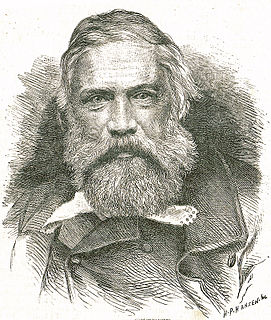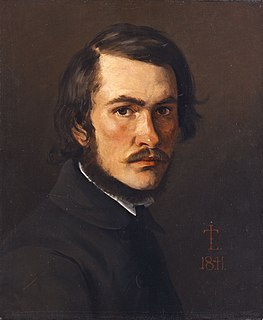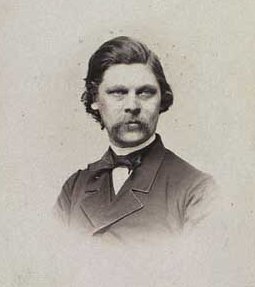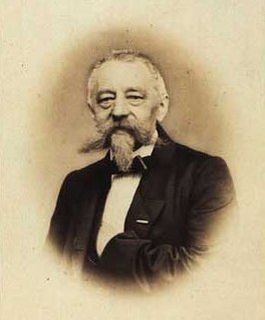Related Research Articles

Carl Christian Constantin Hansen was one of the painters associated with the Golden Age of Danish Painting. He was deeply interested in literature and mythology, and inspired by art historian Niels Laurits Høyen, he tried to recreate a national historical painting based on Norse mythology. He painted also many altarpieces and portraits, including the monumental oil painting The Danish Constituent Assembly between 1861 and 1865.

Peter Vilhelm Carl Kyhn was a Danish landscape painter who belonged to the generation of national romantic painters immediately after the Danish Golden Age and before the Modern Breakthrough. Even though he outlived many of his artistic peers by several decades, he remained a traditionalist and expressed strong criticism of many of the new trends in the painting of his day.

Exposition Universelle

Johan Thomas Lundbye was a Danish painter and graphic artist, known for his animal and landscape paintings. He was inspired by Niels Laurits Høyen's call to develop nationalistic art through depictions of Denmark's characteristic landscapes; the historical buildings and monuments, and the country's simple, rural people. He became one of his generation's national romantic painters, along with P. C. Skovgaard and Lorenz Frølich, to regularly depict the landscape of Zealand.

Peder Mørk Mønsted was a Danish realist painter. He is best known for his landscape paintings in a realistic style. His favorite motifs include snowy winter landscapes, still water and forests.

Danish art is the visual arts produced in Denmark or by Danish artists. It goes back thousands of years with significant artifacts from the 2nd millennium BC, such as the Trundholm sun chariot. For many early periods, it is usually considered as part of the wider Nordic art of Scandinavia. Art from what is today Denmark forms part of the art of the Nordic Bronze Age, and then Norse and Viking art. Danish medieval painting is almost entirely known from church frescos such as those from the 16th-century artist known as the Elmelunde Master.

The Bornholm school of painters (Bornholmerskolen) started to take shape towards the beginning of the 20th century on the Danish island of Bornholm when a number of artists developed a distinctive style of classic modernism, inspired by the island's unique landscapes and light. It was not characterized by a uniform artistic line, but rather by its experiments with color, abstraction and cubism.

Oluf Høst was a Danish Expressionist painter, the only member of the Bornholm school who was a native Bornholmer. Although he studied in Copenhagen, he returned to the Danish island of Bornholm in 1929 where he remained with his family for the rest of his life. Bognemark, a little farmhouse near Gudhjem, was one of Høst's favourite motifs. From 1935 on, he painted the farm some 200 times under varying conditions at different times of the year, often reflecting his particular mood at the time. His home in Gudhjem, built from two fishermen's cottages with a rocky garden in the rear, is named "Norresân" after the nearby harbour, Nørresand Havn, where he painted many of his works.
Kristen "Kræsten" Iversen was a Danish artist who is remembered both for his paintings and his painted glass windows. He was a member of the Bornholm school of painters and a professor at the Royal Danish Academy of Fine Arts .

Kilian Christoffer Zoll was a Swedish painter, graphic artist and illustrator in the style of the Düsseldorf School. He created genre scenes, landscapes, altarpieces and portraits.

Dankvart Dreyer was a Danish landscape painter of the Copenhagen School of painters who was educated under the guidance of Christoffer Wilhelm Eckersberg. Around 1840, he was part of the emerging National Romantic landscape painting scene in Denmark but as a result of his over-dramatic and excessively natural style, he did not fit the aesthetics and the ideology of the period. After being widely criticized, he turned his back on the artistic establishment and passed into near oblivion. In 1852, when only 36 years old, he died from typhus.

Georg Hilker was a Danish decorative painter active during the Danish Golden Age in the first half of the 19th century. He collaborated with painter Constantin Hansen (1804–1880).

Hans Jørgen Hammer was a genre, landscape, and portrait painter and printmaker of the Golden Age of Danish painting. In addition, he served for eleven years as a military officer.

Georg Emil Libert was a Danish landscape painter. His specialties included scenes featuring Danish, German and Norwegian landscapes.

Johannes Knud Ove Jais-Nielsen was a Danish painter, designer and ceramist, best known for the religious figure groups that he designed for the Royal Copenhagen pottery.
Niels Christian Daugaard was a Danish painter.

Frederik Hansen Sødring was a Danish landscape painter and founder of an endowment.

Suzette Catherine Holten was a Danish painter and ceramist who belonged to the Skovgaard family of artists. In addition to landscapes, flower paintings and portraits, she created and decorated ceramics and also worked as an embroiderer. As a woman, she was unable to achieve the same level of success as her father or brothers.

Niels Simonsen was a Danish painter, lithographer and sculptor.

Marie Vilhelmine Bang, commonly known as Ville Bang, (1848–1932) was a Danish painter of portraits, landscapes and genre works. In 1888, together with 22 other women, she presented a petition to the parliament, calling for the Art Academy to be expanded to admit women. It led to the establishment of Kunstakademiets Kunstskole for Kvinder where in October 1888 she was one of the first students. Together with Augusta Paulli, she later opened an art school to prepare women for the Academy.
References
- ↑ "Niels Lergaard". Kunstindeks Danmark & Weilbach Kunstnerleksikon. Retrieved March 1, 2019.CS1 maint: discouraged parameter (link)
- ↑ Niels Lergaard biography from Invaluable.com. Retrieved 11 December 2008.
- ↑ "Bornholmerskolen". Bornholms Kunstmuseum. Retrieved March 1, 2019.CS1 maint: discouraged parameter (link)
- ↑ "Thorvaldsen Medaillen". akademiraadet.dk. Archived from the original on February 2, 2015. Retrieved March 1, 2019.CS1 maint: discouraged parameter (link)